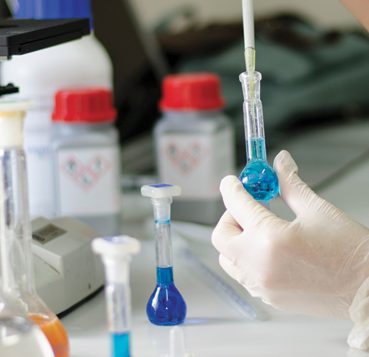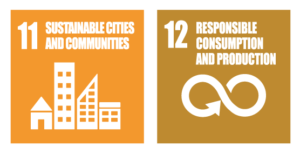
GEEG Geotechnical & Environmental Engineering Group
GEEG carries out research activities based on the development of tests and experimental procedures. The main objective is to develop innovative and sustainable solutions for civil and environmental engineering by improving the understanding of the geotechnical and chemical phenomena involved. Numerous research projects are currently underway in collaboration with universities, research organizations and companies.
Ricerca
GEEG is always available as a promoter or partner for research projects. Currently, several research projects are underway in collaboration with universities, research institutions, and companies.
CHEMICALS
Study of the chemical composition of products, their properties and the effects of individual compounds
The study of the chemical composition of products involves the analysis of the individual compounds present in terms of quantity, purpose, chemical properties, biodegradation and environmental impact.
These studies can be carried out on one or more products, either in general, regardless of their use, or in relation to specific geotechnical, chemical and environmental conditions.
Classification of Foam
The half-life test is one of the most commonly performed laboratory tests to measure the stability of a foam used in EPB-TBM tunnelling. In this article, we presented the results of a large number of laboratory tests carried out in recent years on foam samples produced with different combinations of foaming agents and dosages. The analysis of these data has enabled us to develop a classification system that allows a simple and direct evaluation of the ability of a foaming agent to produce stable foam over time.
CLOGGING RISK
Assessment of the risk of clogging and correlation with the chemical/physical characteristics of the soil
Adhesion studies allow to quantify the natural tendency of the soil to adhere to the metal parts of the TBM (tools and metal carpentry of the cutterhead) and thus to predict the risk of clogging. Specially developed studies provide further information regarding the possible beneficial effect of the use of conditioning agents and, at the same time, the effect of certain characteristic parameters.
In recent decades, the construction of tunnels has become a key element in the development of major infrastructures and urban transportation systems. Naturally, the more complex the historical, urban and environmental context, the more delicate each excavation phase becomes. In this article, presented at the World Tunnel Congress 2019 in Naples, we present the results of a research activity developed at Sapienza University in collaboration with colleagues from Metro C S.c.p.A. The article focuses on the management of conditioning for the mechanized excavation of tunnels with TBMs, one of the many delicate aspects of a project that is unique in the world in terms of size, importance and complexity of the context.
World Tunnel Congress, Napoli 2019
The management of the soil conditioning process for the excavation of the Rome Metro C line
Other publications related to this topic
European Conference of Soil Mechanics and Geotechnical Engineering, Reykjavik 2019
Chemical interaction between fine-grained soil and foaming agents in tunnelling with TBM-EPB
World Tunnel Congress, Bergen 2017
Short and long term effects of chemicals on fine-grained soils
WEAR
Study of the wear of the TBM cutterhead and correlations with ground characteristics and excavation tools
The study of the morphological and mineralogical characteristics of the ground, combined with the performance of laboratory abrasion and wear tests, some of which have been specifically developed by GEEG, enables to estimate the extent of wear-related phenomena that will occur during excavation in coarse-grained soils or rocks.
In the case of EPB-TBM, these studies also provide valuable information regarding the effect of conditioning, the effectiveness of a specific conditioning agent and the dosage required to maximize its lubricating effect.
ENVIRONMENTAL IMPACT
Environmental impact assessment through ecotoxicological and pollutant release studies
The assessment of the environmental impact of products commonly used in civil engineering is a very broad subject involving many disciplines, from chemistry to biology and materials science. GEEG’s research activity focuses on the development of experimental methods, including rapid ones, to estimate the biodegradation times of these substances in the environment, to identify the ecotoxicity characteristics that can guide the disposal of excavated soils, and to assess the release of pollutants. All of these activities are preparatory to the development of plans for the reuse of excavated soils and rocks, which are essential to avoid wasting such a precious resource as soil.
BIODEGRADATION
Analysis of biodegradation kinetics of chemical agents under different environmental conditions
GEEG, in collaboration with contractors and suppliers of conditioning agents, performs laboratory and field activities to measure the kinetics of biodegradation of chemical agents by microorganisms in the environment. Experimental studies are regularly carried out to analyze the influence on biodegradation of various factors such as temperature, type of bacterial inoculum present in the soil, concentration of the chemical agent and type of soil. Also, rapid on-site measurement systems are currently being developed and have already been used in some specific cases.
In this study, we analyzed the effect of metallic iron nanoparticles for the pretreatment of leachate from conditioned soils, reproduced in the laboratory. The experimental results showed how nanoparticles can be used as a heterogeneous catalyst for the development of a heterogeneous Fenton process, which is particularly effective in increasing the biodegradation of treated leachate.
TUNNEL BORING MACHINE
Studies of TBM operations with a focus on monitoring and optimizing performance
GEEG has been carrying out research activities with the aim of optimizing TBM operations and excavation performance. To achieve this goal, GEEG has at its disposal a wide range of data management and analysis tools, from simple spreadsheets to neural networks, as well as the experience gained from monitoring numerous sites and an ever-growing database of real-life cases.
BENTONITE AND POLYMERS
Study of the main chemical-physical properties of bentonite muds and polymer drilling fluids
GEEG conducts research activities on the characterization and recovery of soils and rocks excavated using bentonite and polymeric fluids. These fluids are mainly used to support excavations and to safely remove excavated material during drilling operations.
The fluids consist mainly of chemically synthesized sodium bentonites (smectites) and usually contain, in addition to the main compound, both inorganic and organic additives designed to modify the rheology of the fluid prepared in an aqueous solution and its water retention capacity.
These compounds may have a significant impact on the environment, which is why GEEG carries out experimental and theoretical research aimed at identifying the mechanisms of interaction between the compounds present in the bentonite fluid and the terrestrial and aquatic environmental compartments.
BACKFILLING GROUT
Experimental studies of the chemical and mechanical properties of backfilling materials, including two-component mortars
GEEG develops research activities to contribute to the understanding of the chemical and physical factors that influence the performance of backfill materials and to the standardization of test methods.
These mortars have several functions, including ensuring uniform contact between the surrounding soil and the lining to prevent settlements and/or concentrated loads, supporting the lining rings, bearing part of the loads transmitted by the TBM during driving and complementing the waterproofing. It is therefore clear that these mortars must meet certain performance requirements in terms of workability, setting times and mechanical properties.
The studies that GEEG is developing aim to identify the factors that most influence the performance of two-component mixtures, through the use of repeatable sample preparation procedures (capable of simulating the mixing of the two components during injection) and laboratory tests to measure the strength, stiffness and durability of these materials over time.
A preliminary study of the parameters influencing the perfomance of two-component backfill grout
EXCAVATED SOILS AND ROCKS
Experimental studies on the geotechnical, chemical and environmental properties of excavated soils and rocks for their sustainable management
GEEG has long been developing research activities aimed at rethinking the management and re-use of excavated soils and rocks from a circular economy perspective. By integrating the most commonly proposed re-use methods with innovative and virtuous ones, it is possible to give excavated soils and rocks added value and a profound significance in terms of safeguarding the territory and mitigating hydrogeological risks. Also, reintroducing these materials into new production cycles has considerable economic value.
Expanding the re-use options available to companies and organizations involved in the design and construction of civil engineering works, and sharing information between the research community and stakeholders, will certainly lead to greater environmental awareness and a reduction of the impact of civil engineering works.
These research activities are in line with the Sustainable Development Goals promoted by the United Nations and implemented at European and national level, as well as with the key themes of the Horizon Europe and Green Deal programmers in the areas of industrial sustainability, circular economy and sustainable development.

 English
English
 Français
Français  Italiano
Italiano 








